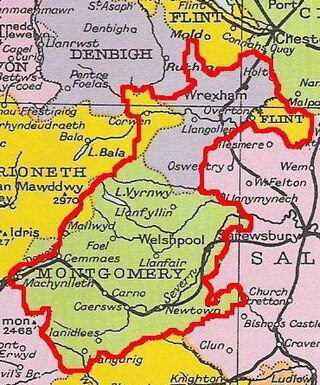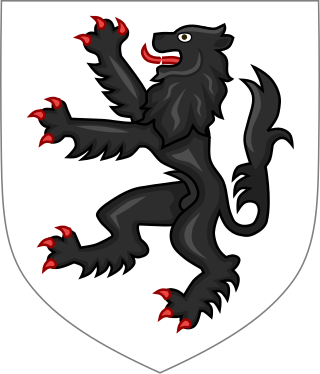
Gruffudd Fychan I, was a Prince of Powys Fadog from 1277 to 1284. He paid homage to Edward Longshanks for the Lordship of Yale, and fought the War of 1282–1283.

Gruffudd Fychan I, was a Prince of Powys Fadog from 1277 to 1284. He paid homage to Edward Longshanks for the Lordship of Yale, and fought the War of 1282–1283.

Gruffudd Fychan I was the youngest of the four sons of Prince Gruffudd ap Madog, Lord of Dinas Bran. On his father's death in 1269 (or 1270) his share was the Lordship of Iâl (Yale) and Edeirnion, which included Glyn Dyfrdwy. [1]
He was aligned to Llywelyn ap Gruffudd, Prince of Wales, against the Anglo-Normans in the Conquest of Wales by Edward I in 1277.
In the peace treaty, it was agreed that he would not do homage to Llywelyn for Edeirnion, but to Edward Longshanks to keep the commote of Iâl (Yale). [2] [3] He again fought alongside Llywelyn during the War of 1282–1283, and lost his lands to the English following his defeat.
Nevertheless, the new Lord of Bromfield and Yale, the Earl of Surrey persuaded the king to allow him possession of his lands, which he held from the king as a tenant at will for the rest of his life. [4]
He died in 1289 leaving a young son, Madog Crypl, who was the heir of the Lordship of Bromfield and Yale, and the Castle of Dinas Bran, also known as Crow Castle. [5]
Madog was put in the wardship of John de Warenne, 6th Earl of Surrey, who later started the construction of Holt Castle in the lordship, and commanded the Battle of Stirling Bridge against Sir William Wallace during the English invasion of Scotland. [6] It was the First War of Scottish Independence.
His son, Lord Madog Crypl, became the great-grandfather of Lord Tudur ap Gruffudd and Owain Glyndŵr, the last native Prince of Wales. [7]

The Kingdom of Powys was a Welsh successor state, petty kingdom and principality that emerged during the Middle Ages following the end of Roman rule in Britain. It very roughly covered the northern two-thirds of the modern county of Powys and part of today's English West Midlands. More precisely, and based on the Romano-British tribal lands of the Ordovices in the west and the Cornovii in the east, its boundaries originally extended from the Cambrian Mountains in the west to include the modern West Midlands region of England in the east. The fertile river valleys of the Severn and Tern are found there, and this region is referred to in later Welsh literature as "the Paradise of Powys".
Madoc is a variation of the Welsh name Madog.

Madog ap Maredudd was the last prince of the entire Kingdom of Powys, Wales. He held for a time, the FitzAlan Lordship of Oswestry, family of the Earls of Arundel, of Arundel Castle. His daughter married Lord Rhys, prince of Wales.

Powys Fadog was the northern portion of the former princely realm of Powys. The princes of Powys Fadog would build their royal seat at Castell Dinas Brân, and their religious center at Valle Crucis Abbey. Some of its lordships included those of Maelor, Mochnant, Glyndyfrdwy, Yale, and Bromfield and Yale. Following the division of Powys, their cousin branch, the princes of Powys Wenwynwyn, would build Powis Castle.

Powys Wenwynwyn or Powys Cyfeiliog was a Welsh kingdom which existed during the high Middle Ages. The realm was the southern portion of the former princely state of Powys which split following the death of Madog ap Maredudd of Powys in 1160: the northern portion (Maelor) went to Gruffydd Maelor and eventually became known as Powys Fadog; while the southern portion (Cyfeiliog) going to Owain Cyfeiliog and becoming known, eventually, as Powys Wenwynwyn after Prince Gwenwynwyn ab Owain, its second ruler.

Gruffydd Maelor was a Prince of Powys Fadog in Wales. He married a daughter of King Owain Gwynedd, first Prince of Wales, and was a brother of Prince Owain Brogyntyn, ancestor of the Barons of Cymmer-yn-Edeirnion.

Madog ap Gruffudd, or Madog ap Gruffudd Maelor, was a Prince of Powys Fadog from 1191 to 1236 in north-east Wales, and Lord of Powys. He was the founder of Valle Crucis Abbey in the Lordship of Yale.

Gruffydd Maelor II was a Prince of Powys Fadog. He reigned for thirty-three years and married into the House of Stanley. Following the Anglo-Welsh Treaty of Montgomery, he submitted to Llywelyn ap Gruffudd, Prince of Wales.

Madog II was a Prince of Powys Fadog from 1269 to 1277. He supported the Prince of Wales, Llywelyn ap Gruffudd, who had married the daughter of Simon de Montfort, 6th Earl of Leicester.

Madog Crypl, also known as Madog ap Gruffydd Fychan was the heir of the sovereign Princes of Powys Fadog and Lords of Dinas Bran. He is sometimes described as Madog III of Powys Fadog. However, he was only lord of some of the family lands under the English crown.

Gruffudd Fychan II was Lord of Glyndyfrdwy and Lord of Cynllaith Owain c.1330–1369. As such, he had a claim to be hereditary Prince of Powys Fadog, and was a member of the Royal House of Mathrafal. His son, Owain Glyndwr, started the Welsh Revolt and became Prince of Wales.
Madog Fychan was a member of the family of Princes of Powys Fadog, though he never gained the title, being brother of Gruffydd Maelor II. He was an ally to Dafydd ap Llywelyn in his campaign to attack English possessions in Wales in 1245 and sided with Llywelyn ap Gruffydd in 1258 in his claim to the title of Prince of Wales. He died in December 1269.

Ial or Yale was a commote of medieval Wales within the cantref of Maelor in the Kingdom of Powys. When the Kingdom was divided in 1160, Maelor became part of the Princely realm of Powys Fadog, and belonged to the Royal House of Mathrafal. Yale eventually merged with another commote and became the Lordship of Bromfield and Yale, later a royal lordship under the Tudors and Stuarts.

The Royal House of Mathrafal began as a cadet branch of the Welsh Royal House of Dinefwr, taking their name from Mathrafal Castle. They effectively replaced the House of Gwertherion, who had been ruling the Kingdom of Powys since late Roman Britain, through the politically advantageous marriage of an ancestor, Merfyn the Oppressor. King Bleddyn ap Cynfyn would join the resistance of the Anglo-Saxon King Harold Godwinson, against the invasion of William the Conqueror, following the Norman Conquest of England. Thereafter, they would struggle with the Plantagenets and the remaining Welsh Royal houses for the control of Wales. Although their fortunes rose and fell over the generations, they are primarily remembered as Kings of Powys and last native Prince of Wales.

Tudur ap Gruffudd (1365–1405), also known as Tudor de Glendore or Tudor Glendower, was the Lord of Gwyddelwern, a junior title of the princely house of Powys Fadog, and was the younger brother of Owain Glyndŵr, the Welsh rebel leader crowned Prince of Wales. His father was Gruffydd Fychan II, the hereditary Prince of Powys Fadog and previous Lord of Gwyddelwern. Along with his brother, Owain Glyndŵr, Tudur was a member of the royal House of Mathrafal.
Fychan is a surname. Notable people with the surname include:

The conquest of Wales by Edward I took place between 1277 and 1283. It is sometimes referred to as the Edwardian conquest of Wales, to distinguish it from the earlier Norman conquest of Wales. In two campaigns, in 1277 and 1282–83, respectively, Edward I of England first greatly reduced the territory of Llywelyn ap Gruffudd, and then completely overran it, as well as the other remaining Welsh principalities.

The Lordship of Bromfield and Yale was formed in 1282 by the merger of the medieval commotes of Marford, Wrexham and Yale. It was part of the Welsh Marches and was within the cantref of Maelor in the former Kingdom of Powys.

Ellis ap Griffith or Elissau ap Gruffudd, was the Baron of Gwyddelwern in Denbighshire, Wales, and the grandnephew of Owen Glendower, Prince of Wales. Following his family defeat during the Glyndwr Rising, his branch inherited the co-representation of the Royal House of Mathrafal, and were immortalized by William Shakespeare in the history play Henry IV. Through his mother Lowrie, he inherited the lordship of his grandfather, Tudor Glendower, and by marriage, the estate of Plas-yn-Yale. By this union, he became the founder of the House of Yale, represented by the Yale family, later known in America as the benefactors of Yale University.